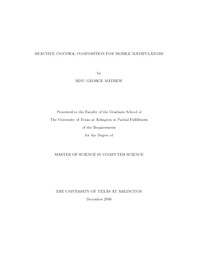
ATTENTION: The works hosted here are being migrated to a new repository that will consolidate resources, improve discoverability, and better show UTA's research impact on the global community. We will update authors as the migration progresses. Please see MavMatrix for more information.
Show simple item record
| dc.contributor.author | Mathew, Binu George | en_US |
| dc.date.accessioned | 2010-07-19T19:54:22Z | |
| dc.date.available | 2010-07-19T19:54:22Z | |
| dc.date.issued | 2010-07-19 | |
| dc.date.submitted | January 2009 | en_US |
| dc.identifier.other | DISS-10519 | en_US |
| dc.identifier.uri | http://hdl.handle.net/10106/4858 | |
| dc.description.abstract | A mobile manipulator is a manipulator mounted on a mobile platform. Due to this combination it has increased mobility compared to a fixed manipulator and increased dexterity compared to a mobile platform. At the same time it has a significantly higher number of degrees of freedom than fixed manipulators or mobile platforms and an increased task and workspace. In particular, the size of the workspace of the manipulator is restricted only by the workspace limitations of the mobile platform and the obstacles around the goal location. In addition, the extra degrees of freedom increase the number of ways in which a particular task can be performed. As a consequence of these properties, the task domain of a mobile manipulator is significantly larger than for other mobile platforms, allowing for a large variety of applications to be addressed. However, the operation of such a system becomes also more challenging because of the increased complexity of the task domain and the unstructured and uncertain environments that the robot generally operates in. Problems like kinematic singularities and non-holonomic constraints arise with increasing frequency and manipulation here critically depends on feedback during its interactions with the environment. As a consequence, a control technique applied to the mobile manipulator must be able to deal with the unstructured, uncertain environment and multiple potentially interacting goals, and be able to address a broad range of operating contexts. It also must be flexible enough to allow the derivation of task-specific control instances without the need for complex reengineering of control structures while ensuring some level of completeness, correctness and robustness. Traditional control methods are challenged when applied to this domain, especially in terms of range of operating contexts. The control basis approach is used in this research to address this. In the control basis approach, behaviour is composed online from a set of base controllers which represent generic control objectives. By varying the composition functions of the base controllers, different tasks can be achieved. In this thesis, a control basis is designed and implemented on a mobile manipulator. Based upon the task, the control composition is derived from the control basis and applied to the robot. To demonstrate its operation, the results of multiple task-specific compositions are applied to and observed on a dynamic robot simulator. | en_US |
| dc.description.sponsorship | Huber, Manfred | en_US |
| dc.language.iso | EN | en_US |
| dc.publisher | Computer Science & Engineering | en_US |
| dc.title | Reactive Control Composition For Mobile Manipulators | en_US |
| dc.type | M.S. | en_US |
| dc.contributor.committeeChair | Huber, Manfred | en_US |
| dc.degree.department | Computer Science & Engineering | en_US |
| dc.degree.discipline | Computer Science & Engineering | en_US |
| dc.degree.grantor | University of Texas at Arlington | en_US |
| dc.degree.level | masters | en_US |
| dc.degree.name | M.S. | en_US |
| dc.identifier.externalLink | https://www.uta.edu/ra/real/editprofile.php?onlyview=1&pid=190 | |
| dc.identifier.externalLinkDescription | Link to Research Profiles | |
Files in this item
- Name:
- Mathew_uta_2502M_10519.pdf
- Size:
- 492.6Kb
- Format:
- PDF
This item appears in the following Collection(s)
Show simple item record


